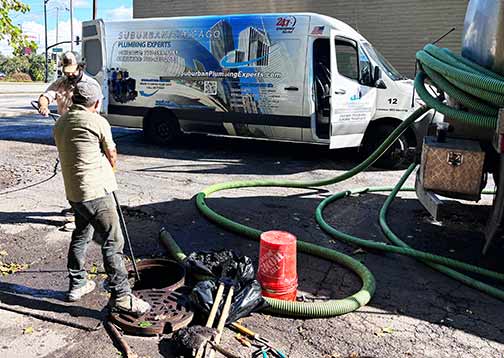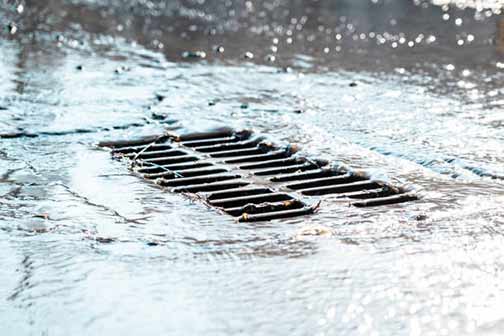Understanding the Importance of Storm Drain Maintenance
Storm drains play a critical role in managing rainwater and preventing flooding in parking lots. These drainage systems are designed to swiftly channel excess water away from paved surfaces, ensuring the safety and functionality of parking areas. However, over time, debris such as leaves, dirt, and litter can accumulate in these drains, leading to blockages and reduced efficiency. Regular maintenance of storm drains is essential to prevent water buildup, which can cause damage to the infrastructure and pose safety hazards to vehicles and pedestrians.
The Challenges of Traditional Cleaning Methods
Traditional methods for cleaning storm drains often involve manual labor, such as using shovels and brooms to remove debris. While these methods can be effective to some extent, they are labor-intensive, time-consuming, and may not fully clear the drainpipes of all obstructions. Additionally, manual cleaning does not address the buildup of sediment and grease that can adhere to the interior surfaces of the pipes. This incomplete cleaning can lead to recurrent blockages and reduced drainage efficiency over time.
Introducing Hydro Jetting: A Revolutionary Approach
Hydro jetting is a modern, innovative technique that utilizes high-pressure water jets to clean and clear storm drains. This method involves the use of specialized equipment that directs powerful streams of water into the drainage pipes, effectively dislodging and flushing away debris, sediment, and grease. Hydro jetting offers a comprehensive cleaning solution that reaches areas traditional methods cannot, ensuring that the entire drainage system is thoroughly cleared and restored to optimal functionality.
The Technology Behind Hydro Jetting
The technology utilized in hydro jetting equipment is both sophisticated and efficient. The system comprises a high-pressure hose with a nozzle that can be adjusted to various spray patterns and pressures to suit different cleaning needs. The equipment is capable of delivering water at pressures up to 4,000 psi, which is sufficient to remove even the most stubborn blockages and buildup within the pipes. The nozzle design allows for 360-degree cleaning, ensuring that all surfaces within the drainpipes are addressed.
Efficiency and Effectiveness of Hydro Jetting
One of the most significant advantages of hydro jetting is its efficiency. The high-pressure water jets can quickly and effectively clear blockages, reducing the time required for maintenance and minimizing disruptions to parking lot operations. Hydro jetting is also highly effective in removing a wide range of materials, including tree roots, which are a common cause of drain blockages. The thoroughness of the cleaning process ensures that drains remain clear for longer periods, reducing the frequency of maintenance and associated costs.

Environmental Benefits of Hydro Jetting
Hydro jetting is an environmentally friendly cleaning method, as it relies solely on water and does not require the use of harsh chemicals. This makes it a safe option for maintaining storm drains in parking lots, where chemical runoff could potentially harm surrounding vegetation and wildlife. Additionally, the efficiency of hydro jetting reduces water usage compared to traditional methods, contributing to overall water conservation efforts.
Cost-Effectiveness of Hydro Jetting
While the initial investment in hydro jetting equipment may be higher than traditional cleaning tools, the long-term cost savings are significant. The thorough cleaning provided by hydro jetting reduces the need for frequent maintenance, lowering labor and operational costs. Furthermore, by preventing blockages and potential damage to the drainage system, hydro jetting helps avoid costly repairs and prolongs the lifespan of the infrastructure.
Safety Considerations in Hydro Jetting
Safety is a paramount concern in any maintenance activity, and hydro jetting is no exception. The high-pressure water jets used in this process require trained operators to ensure safe and effective use. Operators must wear appropriate protective gear and follow established safety protocols to prevent accidents and injuries. Additionally, hydro jetting should be conducted during off-peak hours to minimize disruptions and ensure the safety of parking lot users.
Choosing the Right Hydro Jetting Service Provider
When selecting a hydro jetting service provider, it is essential to consider factors such as experience, reputation, and the quality of equipment used. A reputable provider will have a proven track record of successful projects and satisfied clients. They should also use state-of-the-art equipment and employ trained technicians who are knowledgeable about the latest techniques and safety standards. By choosing the right service provider, parking lot owners can ensure that their storm drains are maintained to the highest standards of efficiency and safety.
Future Trends in Storm Drain Maintenance
As technology continues to advance, the future of storm drain maintenance is likely to see further innovations that enhance efficiency and effectiveness. Developments in sensor technology may allow for real-time monitoring of drainage systems, enabling proactive maintenance and reducing the risk of blockages. Additionally, advancements in hydro jetting equipment may lead to even more powerful and precise cleaning capabilities, further solidifying its position as the preferred method for storm drain maintenance.
To Wrap It Up
In conclusion, hydro jetting stands out as a superior method for cleaning parking lot storm drains, combining cutting-edge technology with unmatched efficiency. Its ability to thoroughly clear blockages and prevent future issues makes it an invaluable tool for maintaining the functionality and safety of drainage systems. By embracing hydro jetting, parking lot owners can ensure that their storm drains are well-maintained, environmentally friendly, and cost-effective, ultimately contributing to the longevity and sustainability of their infrastructure.


